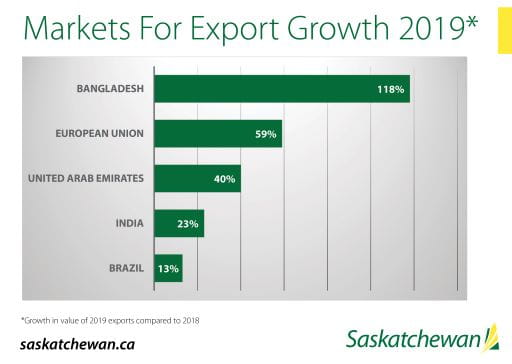Released on March 3, 2020
According to Statistics Canada preliminary trade data 2019, Saskatchewan exported nearly $30 billion worth of products to international markets in 2019 and continued to provide the food, fuel and fertilizer the world needs.
“The success of our economy depends on trade and these numbers are very encouraging, especially considering the market access issues in countries such as China,” Trade and Export Development Minister Jeremy Harrison said. “Our government has made it a priority to diversify markets for our products through trade missions and international engagement and the result of these efforts is unprecedented market diversification in a relatively short period of time. We will continue working to grow our exports, as outlined in Saskatchewan’s Plan for Growth, to build a strong economy that creates more jobs for a strong Saskatchewan.”

Saskatchewan’s top 10 export markets were the United States (U.S.), China, The European Union (EU), Japan, Brazil, India, Indonesia, Bangladesh, Mexico and the United Arab Emirates (UAE). Overall exports were down slightly by 3.0 per cent, due mainly to trade actions by China, which resulted in a decline in exports of 32 per cent to that market.
However, the decline in exports to China was partially offset by the growth in other emerging markets like Bangladesh (118 per cent increase), the EU (59 per cent), the UAE (40 per cent), India (23 per cent) and Brazil (13 per cent).
Saskatchewan’s top export products included crude oil, potash, wheat, pulse crops, canola oil, barley, oats, agricultural machinery, and refined petroleum.

The Government of Saskatchewan maintained an aggressive trade mission agenda in over the past year. This included Premier and Ministerial trade missions to the U.S., Japan, South Korea, India, Mexico, Singapore, Bangladesh, the Philippines, and the EU. Growing the province’s trade and exports is a key component of Saskatchewan’s Growth Plan.
The Plan includes goals to increase the value of exports by 50 per cent, grow the number of international markets to which Saskatchewan exports more than $1 billion annually, grow agri-food exports to $20 billion and increase the value of manufacturing exports by 50 per cent.
The plan includes several initiatives to help achieve these goals. These include opening new international trade and investment offices in Japan, Singapore and India, undertaking SaskFirst new growth tax incentives, maintaining a competitive tax environment and expanding Saskatchewan’s export infrastructure.
-30-
For more information, contact:
Deb Young
Trade and Export Development
Regina
Phone: 306-787-4765
Email: deb.young@gov.sk.ca


